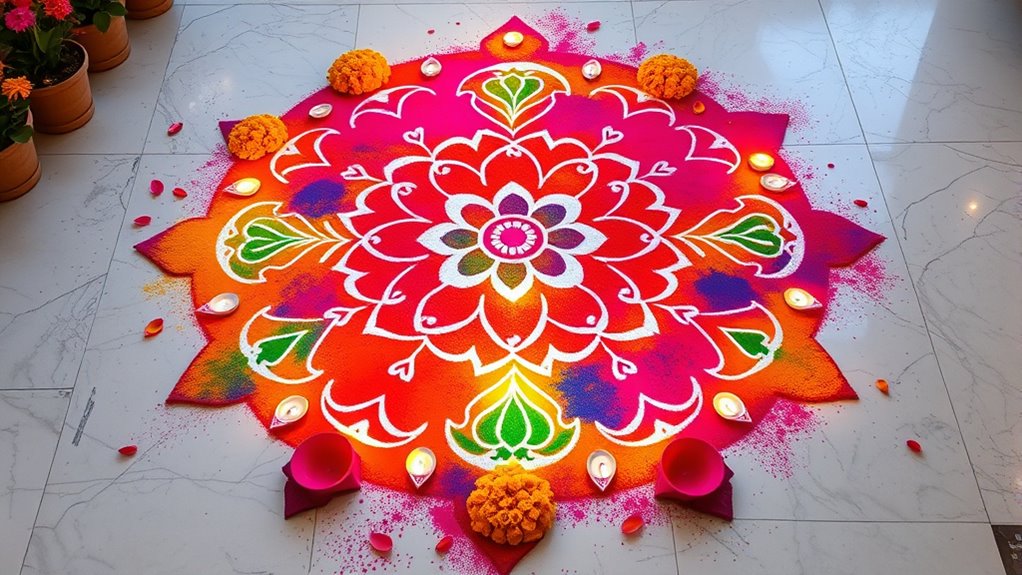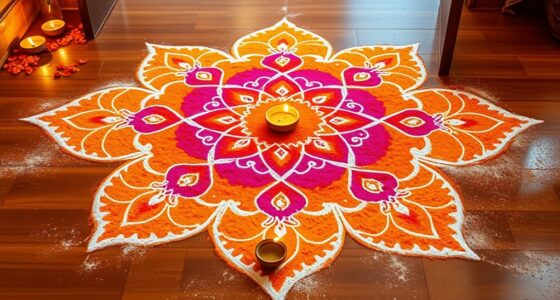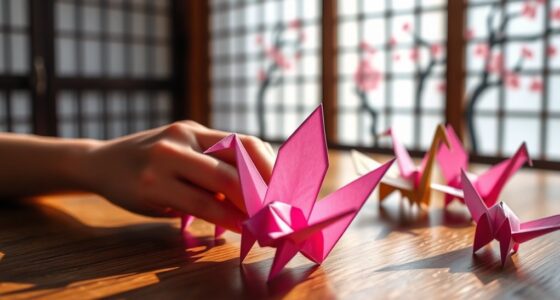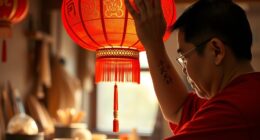When crafting traditional Rangoli art for Indian festivals, you select vibrant colors and meaningful motifs like lotus flowers, peacocks, or religious symbols to create intricate patterns that symbolize prosperity, purity, and spiritual blessings. Focus on symmetry and detail, as these reflect harmony and balance. Involving family and neighbors enhances the communal spirit, making the process both meditative and joyful. Continue exploring to discover how each design can tell a unique cultural story and deepen your festive connection.
Key Takeaways
- Select culturally significant motifs like lotus, peacock, and religious symbols, emphasizing their meanings and traditional importance.
- Use vibrant, symbolic colors such as yellows, oranges, and whites to evoke specific feelings and spiritual themes.
- Employ precise geometric and symmetrical designs to represent harmony, balance, and spiritual unity.
- Collaborate with family and community members to foster shared cultural pride and strengthen social bonds.
- Place the finished Rangoli at entrances during festivals to welcome positivity, ward off evil, and celebrate cultural heritage.
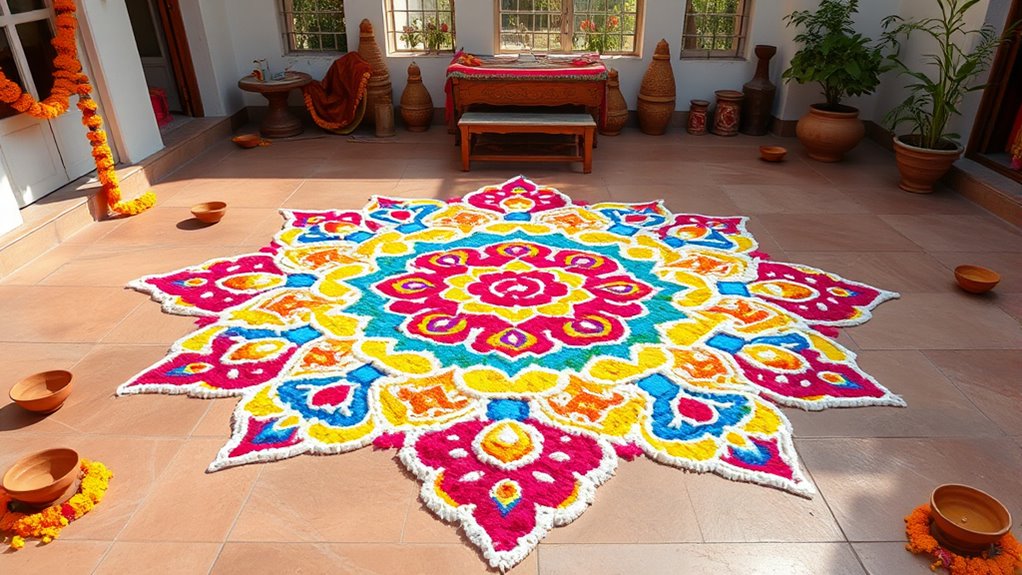
Have you ever wondered how vibrant patterns brighten up Indian festivals and celebrations? It’s more than just decoration; it’s a way to honor traditions and invite positive energy. When you craft traditional Rangoli art, you’re engaging in a practice rooted in deep festival symbolism and cultural significance. Rangoli isn’t merely about creating beautiful designs; it’s a meaningful expression that embodies the spirit of the festival and the community’s heritage. Each pattern you draw or shape carries a message—welcoming guests, warding off evil spirits, or celebrating the divine. These designs serve as a visual language, telling stories and reinforcing cultural identity during special occasions like Diwali, Pongal, or Navratri.
Vibrant Rangoli patterns honor traditions, invite positivity, and tell stories during Indian festivals and celebrations.
As you start your Rangoli, you’re participating in a tradition passed down through generations. The colors and motifs you choose aren’t random; they are carefully selected to evoke specific feelings or symbolize particular virtues. Bright yellows and oranges might represent joy and energy, while white signifies purity and peace. The symmetry and geometric precision often found in Rangoli reflect harmony and balance, which are core elements of Indian cultural values. By creating these patterns, you’re not just decorating a space; you’re embedding your celebration with a layer of cultural depth that connects you to your roots.
The act of making Rangoli also fosters a sense of community and shared cultural significance. It’s common for families and neighbors to come together, each contributing their unique touch to a collective masterpiece. This collaborative effort strengthens bonds and keeps traditions alive. Plus, the process itself is meditative, encouraging mindfulness and patience. You learn to pay attention to detail, respecting the symbolism behind each element. The designs often incorporate motifs like lotus flowers, peacocks, or religious symbols, each adding to the festival’s spiritual ambiance. These symbols aren’t just decorative—they carry meanings that resonate with the festival’s purpose, such as prosperity, beauty, or divine blessings. Additionally, traditional art forms like Aboriginal art Dot also emphasize the importance of storytelling through symbolic patterns, enriching the cultural narrative.
In essence, creating traditional Rangoli art isn’t just an artistic activity; it’s an act of cultural expression and spiritual connection. Every pattern you craft reflects the festival’s deeper message and celebrates India’s rich cultural heritage. When you place your Rangoli at the entrance of your home or in a communal space, you’re welcoming positivity and good fortune, honoring age-old traditions, and sharing a vibrant cultural story with everyone around you. So next time you set out to make a Rangoli, remember—you’re doing more than decorating; you’re keeping alive a beautiful tradition filled with rich symbolism and cultural significance.
Frequently Asked Questions
What Are the Origins of Rangoli Art in Indian Culture?
You might be surprised to learn that rangoli art’s origins date back thousands of years, rooted in ancient Indian traditions. Its cultural significance lies in inviting prosperity and warding off evil spirits during festivals. Regional variations add unique flavors, from geometrical patterns in the North to floral designs in the South. This vibrant art form reflects India’s rich history and deep spiritual connection, making it a cherished part of celebrations nationwide.
Which Materials Are Best for Creating Durable Rangoli Designs?
You should use dye-based powders or natural dyes for creating durable rangoli designs. Dye-based powders, especially those made from synthetic colors, last longer and stay vibrant, even with foot traffic. Natural dyes, derived from flowers, turmeric, or vermilion, offer eco-friendly durability. To guarantee longevity, carefully prepare your materials, and seal your design lightly with a clear spray. This way, your rangoli remains colorful and intact throughout the festival celebrations.
How Can Beginners Improve Their Rangoli-Making Skills?
You’re a budding artist ready to blossom in rangoli making. To improve, practice color blending to create vibrant progressions and focus on pattern symmetry for harmony. Start with simple designs, master basic shapes, and gradually add details. Observe traditional motifs and replicate them to develop your skills. With patience, your confidence will grow, and your rangoli will become a captivating dance of colors and symmetry that celebrates Indian festivals beautifully.
Are There Specific Symbols or Motifs Used in Rangoli?
You’ll notice that traditional patterns and symbolic motifs are commonly used in rangoli designs. Symbols like flowers, peacocks, and diyas represent prosperity, beauty, and light. Incorporate these motifs to add cultural significance and aesthetic appeal to your rangoli. Using traditional patterns helps maintain authenticity and connects your creation to Indian festival celebrations. Experiment with different motifs to create meaningful and vibrant designs that honor tradition while showcasing your creativity.
What Are Eco-Friendly Options for Rangoli Colors?
Imagine transforming your rangoli into a blooming garden—eco-friendly options make it possible. You can use biodegradable powders that wash away easily, leaving no harm behind. Natural dye alternatives, like turmeric, henna, and flower petals, add vibrant colors sustainably. These choices not only protect the environment but also enhance your festival decor, creating a beautiful, conscious celebration. Embrace green practices to make your rangoli truly eco-charming!
Conclusion
As you continue to craft traditional Rangoli art, remember it’s more than just decoration—it’s a celebration of culture and unity. Did you know that over 80% of Indian households participate in Rangoli during festivals? This vibrant art form connects communities and preserves heritage. By creating your own Rangoli, you contribute to a beautiful tradition that spans generations. So, keep your colors bright and your designs meaningful, and let your artistry bring joy to everyone around you.
